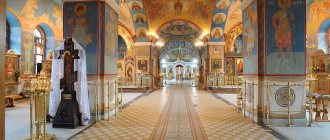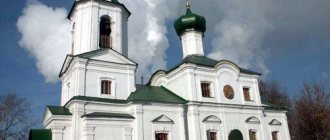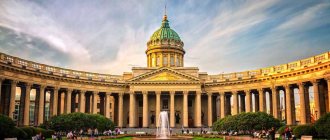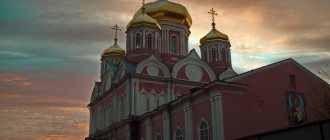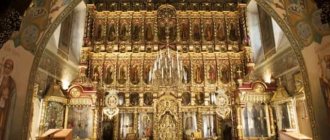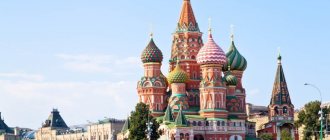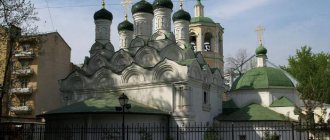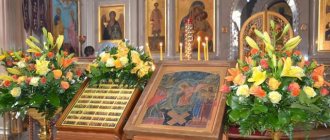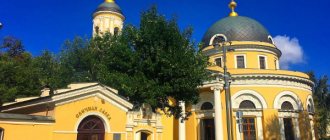“It is good for us here, Lord...” - the words of the Apostle Peter, spoken by him to Christ on the day of his Transfiguration... There once came a time in our country when many people felt bad in the churches, because “they loved darkness more than light.” And temples and cathedrals began to collapse on the orders of the unreasonable government. But there is no night without morning. The Church of the Transfiguration of the Lord on Preobrazhenskaya Square in Moscow was the last victim of the struggle of communism with the Orthodox faith. This church was blown up under the pretext of clearing the area for the construction of the metro in 1964. Since then, not a single temple in the Russian capital has been destroyed.
Russian churches are often built in the shape of a ship. Due to the podium imitating a ship's deck, the Transfiguration Church is especially similar to a seaworthy vessel. Probably, the building, built according to the drawings of the late nineteenth century, could not fit organically into modern architecture. But the churches of God are called to be a kind of “alarm clock” that makes people freeze even for a minute, to think about whether they are going in the right direction. A piece of another world among asphalt, metal and mirrored windows of high-rise buildings. This is the real purpose of the house of God. Everything here is designed to “snatch” a person from endless running in a circle.
Schedule of services
The ground forces of the Russian army have their own church - the Church of the Transfiguration of the Lord on Preobrazhenskaya Square. Schedule of services: morning services begin daily at 8.00. On Sundays, the Liturgy begins at 9.00. Evening services are held daily at 18.00. Those wishing to confess must arrive one hour before the start of the service. Every Sunday after the end of the Liturgy, a prayer service is served. On Fridays and Sundays at 20.00, prayers are held for deliverance from alcohol and drug addiction and for the creation and strengthening of a family.
The Church of the Transfiguration of the Lord on Preobrazhenskaya Square provides an opportunity for members of single-parent, large and low-income families to receive, by appointment, free consultations with specialists: lawyers, psychologists, hairdressers, photographers, pregnancy and childbirth specialists. The Sacraments of Baptism (on Saturdays at 10.00) and Weddings are performed in the church. For adults who want to be baptized, as well as parents and future adoptees of infants, catechetical conversations are held every Wednesday at 20.00 to help them properly prepare for the Sacrament.
Church of the Transfiguration Moscow
In May 2015, one event went almost unnoticed, which, by the way, was very significant in the context of preserving the historical memory of Muscovites. We are talking about the opening of the Church of the Transfiguration of the Lord on Preobrazhenskaya Square. The consecration ceremony took place on the eve of Victory Day.
But the history of the Transfiguration Church is tragic and unique at the same time: never closed, it was demolished literally in a matter of days... in the mid-1960s.
But let's start with a short excursion into history. Many are sure that the village of Preobrazhenskoye was founded by Peter I, and under him the regimental church of his amusing Preobrazhensky Regiment was erected there. But in fact, the first church was mentioned in documents dating back to 1661. In general, these lands belonged to the Alekseevsky Monastery, but Tsar Alexei Mikhailovich, a great fan of falconry, really fell in love with these places and bought them from the monastery. During the hunt, the tsar ordered a tent camp to be set up in Preobrazhenskoe, and a tent-temple to be erected in its center.
In 1747, a certain sergeant Ivan Eliseevich Tretyakov transported here from Semenovskaya Sloboda a wooden building that stood there, the central chapel of which was consecrated in honor of the Transfiguration of the Lord. However, the church quickly fell into disrepair, and its priests began to raise funds for a stone temple.
Soon both money and builders were found. But the arrival of the new church turned out to be small - there were too many Old Believers and fellow believers in these places. But after the revolution, the Church of the Transfiguration unexpectedly became the see of the Moscow metropolitans. Services there did not stop. And when the Great Patriotic War began and the authorities’ attitude towards the clergy became more loyal, parishioners announced a fundraiser for the needs of the front.
People came to the Transfiguration Church not only to pray, but even to spend the night - no bombing could be heard in the church basement. And of course, everyone, without exception, at that time listened attentively to the sermons of Metropolitan Nikolai (Yarushevich). His speeches were recorded and passed on to relatives and friends...
After the war, the parishioners’ love for their church did not fade: there is information that up to a hundred people came to services on weekdays, and on weekends there was a “full church.” There seemed to be no signs of trouble. But in the spring of 1964 they suddenly started talking about the decision to demolish the Church of the Transfiguration. The formal reason was clearly far-fetched - the temple was supposedly located dangerously close to the Kirov radius of the Moscow metro, which was then under construction.
Much later it turned out that the real reasons were completely different. They were hidden in the confrontation between Metropolitan Nikolai and Khrushchev. The fact is that when a new wave of persecution against the Church arose in the 1960s, the bishop tried to resist it. Conflict with N.S. Khrushchev ended in disgrace for Nikolai's father.
After the death of the Metropolitan, the vindictive Secretary General wanted to erase any memory of him. And first of all, the Transfiguration Church. Neither the letters of believers, nor the attempts of the Patriarch to defend the temple yielded any results. Demolition was scheduled for early July 1964. Then believers began to watch the temple around the clock. Representatives of the executive bodies tried to “smoke them out” from there - they threw smoke bombs inside.
People were taken out by force, the temple building was cordoned off, and then, according to eyewitnesses:
“Drillers drilled holes in the walls of the temple and planted explosives. They blew it up according to a special project so that the debris wouldn’t fly away. The explosion was unique - the church stood as it lay down, there was no scattering of debris.”
And people who watched this “unique” explosion from the windows of neighboring houses recalled that there was a bang, and the church “seemed to have risen above the ground and crumbled.” The ruins were removed from Preobrazhenskaya Square in just four hours, so that not the slightest reminder of the church remained.
The restoration of the parish began in 1999. A year later, a petition was sent to the mayor of Moscow to recreate the Church of the Transfiguration. Patriarch Alexy II supported him. The Moscow Committee of Architecture did not object on principle. But the prefecture of the Eastern District objected. Officials unexpectedly spoke out... in defense of the supposedly “unique green spaces” that had long been growing on the site of the former temple and “could not be replanted.” As if something so unique could grow in 30 years in the middle of a noisy metropolis...
But water, as you know, wears away stones. And half a century after its death, the Transfiguration Church again adorns the square, which can now be called Preobrazhenskaya not “by tradition,” but by right.
And what happened to the shrines of the Transfiguration Church then, in the mid-1960s? Thanks to the intervention of Patriarch Alexy I, they were saved. The fact is that the Patriarch, trying to prevent demolition and at the same time realizing that the fate of the temple was predetermined, warned about the consequences of such barbarity:
“This actual destruction of one of the famous, and ancient, churches may lead to undesirable complications... It may become the property of foreign propaganda, which will undoubtedly interpret the destruction of the Moscow parish church as a phenomenon of administrative pressure and infringement of the rights of believing citizens.”
As a result, in order to somehow smooth out the situation, Alexy I proposed to provide the parishioners with another church building in order to transfer the shrines of the Transfiguration Church there. The authorities chose the Church of the Resurrection in Sokolniki as such a temple.
This is where a kind of confrontation between the parishes began, fueled, of course, from the outside: Nikita Sergeevich really wanted that the parish of the Transfiguration Church itself would not remain! As a result, the “Preobrazhensky” people were prevented in every possible way from performing their rituals, and a year later the community of the former Transfiguration Church was deregistered.
Orthodox churches in Moscow.
Temple location
One of the attractions of the northeastern part of the capital for an Orthodox pilgrim is the Church of the Transfiguration of the Lord on Preobrazhenskaya Square. Address: Moscow, Preobrazhenskaya Square, 9-a. Every church has its own special spirit. At this temple he is one with the spirit of the regiment of the same name. This unity was expressed in the design of the entire square. All its details strive to emphasize the idea of combining the spiritual and secular, in this case, the Orthodox and fighting spirit. Nearby, on the site of a mass grave, there is a monument to the soldiers of the Preobrazhensky Regiment with an image of their breastplate. Nearby there is a park of linden and maple trees where you can sit. All this constitutes a single memorial dedicated to the history of the origins of the Russian army and the origins of the regiment, whose history is closely connected with the history of the church of the same name, which, among other things, is a symbol of the spiritual strength of the Russian army.
Moscowolk
- Created: 05/22/2015 15:29
For the 70th anniversary of Victory in the Great Patriotic War, the Temple was restored on Preobrazhenskaya Square, and a comprehensive improvement of the adjacent square was also completed. During Soviet times, the church was one of the most famous strongholds of Orthodoxy in Moscow. On the night of July 17-18, 1964, the Church of the Transfiguration of the Lord was blown up under the pretext of subway construction. This was the last case of destruction of an active church in Moscow.
The Church of the Transfiguration of the Lord on Preobrazhenskaya Square was founded on the territory of the Regimental Court of the Life Guards Regiment of the Preobrazhensky Regiment (1743-1747). Blown up in 1964 Restored to its original location with the blessing of Patriarch of Moscow and All Rus' Alexei II and by order of the Moscow Government. Consecrated by Patriarch Kirill of Moscow and All Rus' on May 8, 2015.
History: In 1747, a sergeant of the Preobrazhensky regiment acquired the building of an old wooden church next door, in Semenovsky. The log house was transported to Preobrazhenskoye and installed in the regimental yard of the Preobrazhensky Regiment, on the site of the linen temporary church. On July 19, 1747, the church was consecrated in honor of the heavenly patrons of Peter I - the apostles Peter and Paul. The throne in the name of the Transfiguration of the Savior, which later became the main one, was consecrated in 1800.
In 1763, parishioners decided to build a new stone church, and collection of donations began. Construction of a new temple began two years later, next to the old wooden church. By 1768, construction was completed and the temple was operational. In 1781, the chapel of Peter and Paul and the bell tower were added to it. During the Moscow fire of 1812, the church was not damaged, services in it did not stop during the entire stay of the French army in Moscow. Beginning in 1830, with the active participation of the merchant Kotov, who was elected church warden, the temple began to improve and grow rich. In 1856, the Preobrazhensky Regiment donated the icon of the Transfiguration of the Lord to the church. On May 23, 1883, before the celebration of the 200th anniversary of the regiment, Alexander III visited the church. After the emperor’s visit, a second chapel was built in the Transfiguration Church in the name of Alexander Nevsky.
Arrivals have been made for disabled people and parishioners with strollers
Light and spacious inside
A park was created in front of the Temple
There is a monument to the Soldiers of the Preobrazhensky Regiment on the square.
Since the temple is closely connected with the history of the Preobrazhensky Guards Regiment, a monument to the “Preobrazhensky” soldiers and officers who died in the wars for the Fatherland was erected near its walls
Preobrazhensky Life Guards Regiment. The regiment was formed by Tsar Peter I in 1691 from the amusing village of Preobrazhenskoye, from which it received its name.
Benches were installed in the park. In the evenings a lot of young people gather here
The square is surrounded by greenery, many bushes and trees have been planted
Along with the revival of the Temple, residents received a green recreation area
This is how Preobrazhenskaya Square has been transformed (all the stalls have been demolished)
Tweet
Home page
www.moscowalk.ru
Add a comment
From consecration to explosion
The Church of the Transfiguration of the Lord on Preobrazhenskaya Square was built in the mid-eighteenth century. It was dedicated to the holy chief apostles Peter and Paul, and the main chapel to the feast of the Transfiguration of the Lord. In 1760, they began to build a stone temple, which stood until demolition in 1964. The new temple was consecrated in 1768. Until the moment of destruction, the Church of the Transfiguration did not close and was, until the revolution, one of many inconspicuous churches on the outskirts of the capital.
At the beginning of the twentieth century, the Church of the Transfiguration of the Lord on Preobrazhenskaya Square became a cathedral. After the revolution, many shrines and icons were brought here from neighboring churches that were closing. One of the significant spiritual centers of Moscow appeared here. During the war, churches again became a refuge for the grieving and destitute people, who always found consolation here. In 1964, when rumors of demolition appeared, parishioners of about 100 people locked themselves in the temple. About a thousand believers stood around him. For a week the workers could not get to the church. When the defenders of the temple, having calmed down, dispersed, a terrible explosion was heard at night, and they realized that they had been deceived. But, apparently, the prayer of the people who united to protect the church was so fervent that a miracle happened. The metro station, which was supposed to be built on the site of the temple, was built in a different place. Instead, they built a public garden. Since then, churches have no longer been destroyed in Moscow. And the parishioners still have hope for the restoration of the temple.
The Moscow Cathedral of Christ the Savior (“Upper Temple”) is located in the Khamovniki district and dates back to the first half of the 19th century. At its current location, it was originally built in 1839-1883 and existed until December 5, 1931, when it was blown up by order of Stalin. The lower temple, or, as it is more officially called, the Church of the Transfiguration of the Lord, the Transfiguration Church, the Church of the Transfiguration, is a new building on the site of a once-existing hill, razed in the 1930s during the construction of the Palace of the Soviets. The date of the official opening, the Great Consecration, of the Lower Church is considered to be the day of the Transfiguration of the Lord - August 19, 1996. It turns out that the Lower Church opened its doors to believers exactly 4 years earlier than the Upper Church.
The temple is located in the stylobate part of the Complex. Services are held there on weekdays, but during the warm season they are usually transferred to the nearby Summer Wooden Church-Chapel of the Sovereign Icon of the Mother of God, which was built in 1995 and next to which a granite foundation stone was installed back in 1990.
A visit to the observation deck of the Upper Church with a tour of the surrounding area and sights of Moscow is also provided.
On the excursion you will learn:
- about the history of the place where the Cathedral of Christ the Savior (CHS) stands.
- about the objects that make up the ХХС Complex, and about the people who participated in the reconstruction of the ХХС.
- about the foundation stone and capsule.
- about the reasons for the creation of the Lower Temple in the modern Temple complex.
- about the Alekseevsky Convent and how its history is intertwined with the history of the KhHS.
- about the boundaries and altars of the Lower Temple and about the sacraments that are performed in the Lower Temple.
- about what a stylobate is.
- about the artist Evgraf Sorokin, about embroidered icons and about the Feast of the Intercession of the Blessed Virgin Mary
- much more.
On the tour you will see:
- The icon of the “Savior Not Made by Hands,” rescued from the bombed Cathedral of Christ the Savior, and other especially revered icons, you will get acquainted with the interior decoration of the Lower Church.
- ceiling paintings, including a painting dedicated to one of the churches that stood in the immediate vicinity until 1932.
- Moscow from the height of the panoramic platform,
- Church of the Sovereign Icon of the Mother of God (from the outside), Patriarchal Square (when open)
- and much more.
Meeting point : the center of the hall of the Kropotkinskaya metro station.
How to find : the guide will stand at the meeting point with a sign.
Route : movement to the Temple - Patriarchal Square (if it is open) and inspection of the facades of the Upper Temple and the appearance of the Temple of the Sovereign Icon of the Mother of God - inspection of boards with the names of sponsors - inspection of the side chapels, icons and ceiling paintings of the Lower Temple - panoramic platform at an altitude of 40.2 m.
Tour guide Andrey Efremov.
Conditions for booking excursions:
- The tourist is obliged to provide the necessary correct data to establish operational communication
- For bus tours, pre-seating is not provided in the cabin - Money paid for the excursion is subject to refund in case of cancellation, replacement or postponement of the excursion under the initiative “I will show you Moscow”
- Please carefully read the terms of purchase: If it is impossible to attend the event for which the ticket was purchased, money for tickets can be returned in accordance with Federal Law No. 193. If before the start of the event: more than 10 days, the cost of the ticket is returned in full minus a service fee of 5 %; from 5 to 10 days - 50% of the ticket price is refunded; from 3 to 5 days - at least 30% of the ticket price is returned; less than 3 days - the cost is not refundable.
- In case of being late or no-show for the excursion (for any reason), the money is not refunded and the tour is not rescheduled to another date.
- During periods of deteriorating weather (snowfalls, drifts on the roads, low/high air temperatures, showers, floods, storms, etc.), the company reserves the right to cancel excursions and, in exceptional cases, change the tour program. The decision on replacement/cancellation is made by the guide.
Temple today
In 2009, the reconstruction of the Church of the Transfiguration began in the form in which it existed at the time of destruction, according to drawings from 1883 and the latest photographs. Now it is the temple of the Preobrazhensky Regiment, which was completely completed and consecrated in 2015. It has five aisles. At the bottom of the temple there is a font for adults. The church has a library and a Sunday school.
During the consecration, copies of all the banners of the Preobrazhensky regiment and the original of the very first banner were installed in the church. At the temple there is a museum of the history of the Preobrazhensky Regiment and the birth of the Russian army.
A little history
The temple was built back in the 18th century. It was consecrated in honor of the revered apostles Peter and Paul. Its main chapel is in honor of the Transfiguration of the Lord. A little later, construction was carried out using stone building materials, which lasted until the explosion.
In the 19th century, the temple became a cathedral, and after the revolution, a large number of miraculous holy images were brought from neighboring churches, which were closed by the authorities. During the war, the church was a refuge for people. Just before they wanted to demolish the temple, about 150 people locked themselves in it as a sign of protecting the building. The authorities promised that they would not touch him; people believed him and dispersed. That same night the temple was blown up.
The best article for you, go to: St. Isaac's Cathedral in St. Petersburg
After 2008, restoration of the temple began in its original location. Since the construction planned by the state was carried out in another place. The church was restored in the form in which it existed before the explosion. Today, all five limits have been completely rebuilt. During the restoration, all copies of the banners of the Preobrazhensky Regiment were restored.
Today there is a Sunday school there. There is also a museum of the history of the Preobrazhensky Regiment. Anyone can visit it.

